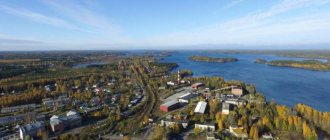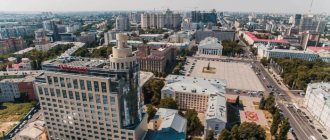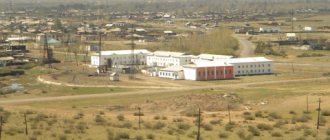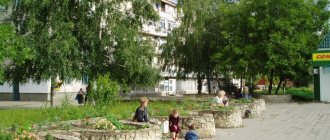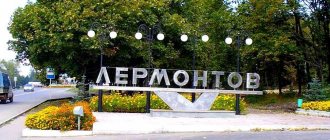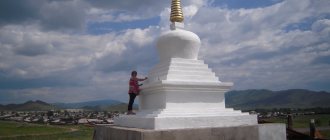This article is about the city. For the urban district, see Urban district of the city of Buinaksk.
| City Buynaksk godfather Shura
|
| A country | Russia, Russia |
| Subject of the federation | DagestanDagestan |
| Urban district | Buinaksk city |
| Coordinates | 42°49′00″ n. w. 47°07′00″ E. d. / 42.81667° n. w. 47.11667° east. d. / 42.81667; 47.11667 (G) [www.openstreetmap.org/?mlat=42.81667&mlon=47.11667&zoom=12 (O)] (Z)Coordinates: 42°49′00″ N. w. 47°07′00″ E. d. / 42.81667° n. w. 47.11667° east. d. / 42.81667; 47.11667 (G) [www.openstreetmap.org/?mlat=42.81667&mlon=47.11667&zoom=12 (O)] (I) |
| Chapter | Gamzatov Guseyn Abdulaevich |
| Based | in 1834 |
| Former names | until 1922 - Temir-Khan-Shura |
| City with | 1866 |
| Square | 20.95[1]km² |
| Center height | 490 |
| Population | ↗63,888[2] people (2016) |
| Density | 3049.55 people/km² |
| National composition | Kumyks, Avars, Russians, Laks, Dargins, Lezgins, etc. |
| Confessional composition | Sunni Muslims, Orthodox |
| Names of residents | buynaktsy, buynakets, buynachka |
| Timezone | UTC+3 |
| Telephone code | +7 87237 |
| Postcode | 368220 |
| Vehicle code | 05 |
| OKATO code | [classif.spb.ru/classificators/view/okt.php?st=A&kr=1&kod=82405 82 405] |
| Official site | [buynaksk05.ru/ k05.ru] |
| Buynaksk Moscow |
| Makhachkala Buynaksk |
K: Settlements founded in 1834
Buynaksk
- a city in southern Russia, the administrative center of the Buinaksky region of Dagestan. The urban district is formed by the city of Buinaksk.
Story
Foundation of the fortress
According to legend, the foundation of the city is associated with the name of Tamerlane (Temir Khan). In 1396, Tamerlane’s army camped near a lake called by the mountaineers Temir-Khan-Shura
(Shurai is a Dargin “lake”[3][4][5], Shere is a Kumyk word[6], that is, all together - “Tamerlane’s lake”; the lake was drained in 1854). At the site where the army was stationed, an aul of the same name arose, which was first part of the possessions of the Tarkov shamkhal, then a special inheritance of Bamat.
In 1832, a Russian fortification with the same name was founded near the village, in 1834 it was expanded and designated as the seat of the commander of the troops in Northern Dagestan. On November 11, 1843, Shamil besieged this fortification, defended by a garrison of 4 thousand people, but could not take it and on December 15 he was defeated by Major General R. K. Freytag, who came to the rescue. In 1847, the fortress was designated as the seat of the manager of the civil part in the Caspian region.
Temir-Khan-Shura before 1917
Since 1866, Temir-Khan-Shura received city rights and became the administrative center of the Dagestan region. At the end of the 19th century, the city had 9,089 inhabitants (counting a garrison of 2,427 people): 4,633 Orthodox, 1,950 Jews, 1,241 Muslims (455 of them Shiites, the rest Sunnis), 685 Armenians, 433 Catholics, 121 Protestants and 26 Old Believers. There were 634 residential buildings and 128 shops and warehouses; real, parochial and primary city schools, a women's gymnasium, 2 Jewish schools, a hospital, an outpatient clinic, a military hospital, a printing house, photography and a real school library. 4 churches (2 Orthodox (St. Andrew's Military Cathedral), Catholic and Armenian), 2 mosques, 2 synagogues. 10 factories and factories (brewing, brick, soap, etc.). Monuments: to Prince M.Z. Argutinsky-Dolgorukov, private Agafon Nikitin and in memory of the capture of Gunib.
XX century
In November 1919 - May 1920, Temir-Khan-Shura was the seat of the government of the Mountain Republic of the North Caucasus. After that, until the spring of 1920, it was under the authority of Denikin’s Government of the South of Russia.
On November 13, 1920, at the extraordinary congress of the peoples of the Caucasus in Temir-Khan-Shura, People's Commissar for Nationalities Stalin declared Dagestan an autonomous republic. In 1922, the city was renamed in honor of U. D. Buynaksky, a participant in the struggle for Soviet power in Dagestan.
Buinaksk was heavily damaged during the earthquake on May 14, 1970.
On September 4, 1999, a terrorist attack occurred in Buinaksk, which marked the beginning of a series of explosions of residential buildings.
Modernity
On September 4, 1999, a terrorist attack in the city killed more than 60 people and injured hundreds. Two multi-storey buildings and dozens of private houses were destroyed.
On August 13, 2009, on the outskirts of the city, a police post and a sauna located a few meters away were attacked. 11 people died.
On August 20, 2013, during the storming of a residential building in Buynaksk, 10 militants were killed, including Bammatkhan Sheikhov, the leader of the Buynaksk group of illegal armed groups.
Climate
The climate of Buinaksk is temperate continental. [7]
| Climate of Buinaksk (norm 1981—2010) | |||||||||||||
| Index | Jan. | Feb. | March | Apr. | May | June | July | Aug. | Sep. | Oct. | Nov. | Dec. | Year |
| Average temperature, °C | −0,8 | −0,6 | 3,6 | 10,1 | 15,2 | 20,0 | 22,8 | 22,1 | 17,2 | 11,2 | 5,1 | 0,7 | 10,6 |
| Precipitation rate | 18 | 22 | 25 | 32 | 63 | 69 | 56 | 50 | 59 | 39 | 30 | 18 | 481 |
| Source: [meteo.ru/it/178-aisori FSBI “VNIIGMI-MTsD”] | |||||||||||||
Statistical data
| Indicator[24] | 2001 | 2002 |
| Standard of living of the population and social sphere | ||
| Average monthly nominal accrued wages, rub. | 924 | 1687 |
| Average housing area per inhabitant (at the end of the year), m² | 17.6 | 17.9 |
| Number of preschool institutions, pcs. | 17 | 17 |
| Number of children in preschool institutions, thousand people | 2.1 | 2.1 |
| Number of daytime educational institutions (at the beginning of the school year), pcs. | 16 | 15 |
| Number of students in daytime educational institutions, thousand people | 10.7 | 10.4 |
| Number of doctors, people. | 337 | 330 |
| Number of nursing staff, people. | 942 | 940 |
| Number of hospital institutions, pcs. | 5 | 5 |
| Number of hospital beds, thousand units | 1.6 | 1.6 |
| Number of medical outpatient clinics, pcs. | 3 | 3 |
| Capacity of medical outpatient clinics, visits per shift, thousand units. | 1.9 | 1.9 |
| Number of registered crimes, pcs. | 417 | 330 |
| Persons who committed crimes were identified, persons. | 335 | 284 |
| Economy, industry | ||
| Number of enterprises and organizations (at the end of the year), pcs. | 1304 | 1333 |
| Number of operating industrial enterprises (at the end of the year), pcs. | 15 | 17 |
| Volume of industrial production (in actual prices), million rubles. | 34.9 | 59 |
| Industrial production index, % compared to the previous year | 190.9 | 143.5 |
| Construction | ||
| Volume of work performed under construction contracts, million rubles. | — | 46.2 |
| Commissioning of residential buildings, thousand m² of total area | 9.8 | 15.2 |
| Commissioning of residential buildings, apartments | 56 | 61 |
| Transport | ||
| Number of bus routes (in intracity traffic), pcs. | 5 | 5 |
| Number of passengers transported by buses per year (in intracity traffic), million people. | 0.3 | 0.5 |
| Trade and services to the population | ||
| Retail trade turnover (in actual prices), million rubles. | 482.3 | 637.1 |
| Volume of paid services to the population (in actual prices), million rubles. | 54.5 | 51.7 |
| Volume of household services to the population (in actual prices), million rubles. | 14.5 | 12.3 |
| Investments | ||
| Investments in fixed assets (in actual prices), million rubles. | — | 32.6 |
Population
The population, according to the 2010 Russian Federation Census, was 62,623 people (in 1897 - 9.2 thousand people, in 1926 - 9.5 thousand people, in 1979 - 45.1 thousand people, in 1992 - 58.5 thousand people, in 2002 - 61,437 people).
National composition of the population as of 2002:
| Number of people, people | Share, % | |
| Avars | 28 289 | 46,0% |
| Kumyks | 19 304 | 31,4% |
| Laktsy | 4 219 | 6,9% |
| Dargins | 3 791 | 6,2% |
| Russians | 3 710 | 6,0% |
| Lezgins | 475 | 0,8% |
| Azerbaijanis | 403 | 0,7% |
| Tabasarans | 136 | 0,2% |
| Chechens | 114 | 0,2% |
| Mountain Jews | 49 | 0,1% |
| Nogais | 47 | 0,1% |
| Others | 936 | 0,2% |
Economy
Industry
Factories:
furniture, shoe, knitwear, sewing. (not functioning)
Factories:
aggregate, instrument-making and tire repair, canning (produces preserves, jams, compotes).
The Buinaksk Aggregate Plant produces hydraulic and fuel units, electronics. Trade
| This section of the article has not been written. According to the plan of one of the Wikipedia participants, a special section should be located in this place. You can help by writing this section. |
Financial services
| This section of the article has not been written. According to the plan of one of the Wikipedia participants, a special section should be located in this place. You can help by writing this section. |
Map
| Buynaksk: maps |
Buinaksk: photo from space (Google Maps) Buinaksk: photo from space (Microsoft Virtual Earth)
| Buynaksk Nearest cities. Distances in km. on the map (in brackets along roads) + direction. Using the hyperlink in the distance , you can get the route (information courtesy of the AutoTransInfo website) | |||
| 1 | Kafir-Kumukh | 3 () | NE |
| 2 | Halimbekaul | 4 () | NE |
| 3 | Nizhneye Kazanische | 6 () | SE |
| 4 | Verkhneye Kazanische | 9 () | YU |
| 5 | Lower Dzhengutai | 16 () | SE |
| 6 | Chirkey | 19 () | NW |
| 7 | Dorgeli | 21 () | SE |
| 8 | Leninkent | 25 () | NE |
| 9 | Korkmaskala | 27 () | NE |
| 10 | Kaka-Shura | 28 () | SE |
| 11 | Shamkhal-Termen | 28 () | NE |
| 12 | Tube | 29 () | NE |
| 13 | Untsukul | 29 () | SW |
| 14 | Semender | 29 () | NE |
| 15 | Dubki | 32 () | NW |
| 16 | Shamkhal | 32 () | NE |
| 17 | Alburikent | 33 () | NE |
| 18 | Kyakhulai | 33 () | NE |
| 19 | Gergebil | 34 () | YU |
| 20 | Tarki | 34 () | NE |
| 21 | New Kyakhulai | 35 () | IN |
| 22 | Makhachkala | 35 (41) | NE |
| 23 | New Khushet | 36 () | IN |
| 24 | New Chirkey | 38 () | WITH |
| 25 | Karabudakhkent | 38 () | IN |
| 26 | Kaspiysk | 42 () | IN |
| 27 | Stalskoe | 43 () | WITH |
| 28 | Khajalmahi | 44 () | YU |
| 29 | Lefties | 45 () | YU |
| 30 | Gurbuki | 45 () | SE |
| 31 | Khunzakh | 45 () | SW |
| 32 | Bavtugay | 45 () | NW |
a brief description of
Located in the foothills of the Greater Caucasus, on the river. Shura-Ozen, 41 km southwest of Makhachkala. Railway station. Road junction.
In the vicinity of Buinaksk there is a climatic resort area (anti-tuberculosis sanatoriums, etc.).
Territory (sq. km): 21
Information about the city of Buynaksk on the Russian Wikipedia site
Historical sketch
According to legend, the founding of the city is associated with the name of Tamerlane (Temir Khan). In 1396, Tamerlane’s army, returning from a campaign against the Golden Horde and Rus', camped near a lake called Temir-Khan-Shura by the highlanders; an aul of the same name soon arose at the site of the army’s camp (the lake was drained in 1854).
The city is advantageously located near the mountain passes to the interior regions of Dagestan, and in 1834 Russian military fortifications were built near the village - the Temir-Khan-Shura fortress. Shura Kumyk “lake”, i.e. all together “Lake Tamerlane”. During the Caucasian War (1817-64), the Temir-Khan-Shura fortress in 1843 withstood a half-month siege of the highlanders led by Imam Shamil, and in 1849 - a raid by Hadji Murad's horsemen.
Since 1847 - the place of residence of the manager of the civil part in the Caspian region, since 1860 - in the Dagestan region. The city since 1866, the center of the Dagestan region.
In the 19th century, especially after the end of the Caucasian War, the city attracted the attention of cultural figures. In Temir-Khan-Shura there were poets and writers A.I. Polezhaev, A.A. Bestuzhev-Marlinsky, artists F.T. Rubo, I.K. Aivazovsky, N.A. Yaroshenko, writer A. Dumas the father, etc.
In November 1920, the autonomy of Dagestan was proclaimed in Temir-Khan-Shura. In 1922, it was renamed in honor of Ullubiy D. Buinaksky (1890-1919), a participant in the struggle for Soviet power in Dagestan.
Buinaksk was heavily damaged during the earthquake on May 14, 1970.
Municipal indicators
| Index | 2001 |
| Demography | |
| Number of births, per 1000 population | 14 |
| Number of deaths, per 1000 population | 7.5 |
| Natural increase (decrease), per 1000 population | 6.5 |
| Standard of living of the population and social sphere | |
| Average monthly nominal accrued wages, rub. | 924 |
| Average housing area per inhabitant (at the end of the year), sq.m. | 17.6 |
| Number of preschool institutions, pcs. | 17 |
| Number of children in preschool institutions, thousand people | 2.1 |
| Number of daytime educational institutions (at the beginning of the school year), pcs. | 16 |
| Number of students in daytime educational institutions, thousand people | 10.7 |
| Number of doctors, people. | 337 |
| Number of nursing staff, people. | 942 |
| Number of hospital institutions, pcs. | 5 |
| Number of hospital beds, thousand units | 1.6 |
| Number of medical outpatient clinics, pcs. | 3 |
| Capacity of medical outpatient clinics, visits per shift, thousand units. | 1.9 |
| Number of registered crimes, pcs. | 417 |
| Persons who committed crimes were identified, persons. | 335 |
| Economy, industry | |
| Number of enterprises and organizations (at the end of the year), pcs. | 1304 |
| Construction | |
| Volume of work performed by type of activity “Construction” (until 2004 - volume of work performed under construction contracts), million rubles. | 0 |
| Commissioning of residential buildings, thousand sq.m. of total area | 9.8 |
| Commissioning of residential buildings, apartments | 56 |
| Commissioning of preschool institutions, places | 0 |
| Commissioning of educational institutions, places | 0 |
| Commissioning of hospital facilities, beds | 0 |
| Commissioning of outpatient clinics, visits per shift | 0 |
| Transport | |
| Number of bus routes (in intracity traffic), pcs. | 5 |
| Number of passengers transported by buses per year (in intracity traffic), million people. | 0.3 |
| Connection | |
| Number of residential telephone sets of the city public telephone network, thousand units. | 6.5 |
| Trade and services to the population | |
| Retail trade turnover (in actual prices), million rubles. | 482.3 |
| Retail trade turnover (in actual prices), per capita, rub. | 8659 |
| Public catering turnover (in actual prices), million rubles. | 4 |
| Volume of paid services to the population (in actual prices), million rubles. | 54.5 |
| Volume of paid services to the population (in actual prices), per capita, rub. | 978.3 |
| Volume of household services to the population (in actual prices), million rubles. | 14.5 |
| Volume of household services to the population (in actual prices), per capita, rub. | 260.7 |
| Investments | |
| Investments in fixed assets (in actual prices), million rubles. | 0 |
| Share of investments in fixed assets financed from budgetary funds in the total volume of investments, % | 0 |
Data sources:
- Regions of Russia. Main characteristics of the constituent entities of the Russian Federation: statistical collection. Goskomstat of Russia. - M:, 2003.
Economy
Factories: furniture, shoe, knitwear, sewing. Factories: aggregate, instrument-making and tire repair, canning (produces preserves, jams, compotes).
Main enterprises
MECHANICAL ENGINEERING AND METAL WORKING
OJSC "Buinaksk Aggregate Plant"
368200, Republic of Dagestan, Buinaksk, st.
Promyshlennaya, 1 Offers:
hydraulic and fuel units, electronics
Culture, science, education
Avar Drama Theater.
The largest mosque and madrasah in the North Caucasus.
Universities of the city
Dagestan Cooperative Institute (branch) of the Belgorod University of Consumer Cooperation
368220, Republic of Dagestan, Buinaksk, Sadovaya st., 116-A WWW: https://www.dagki.ru/
Branch of Dagestan State University in Buinaksk
368220, Republic of Dagestan, Buinaksk, st. Imam Gazimagomed, 46
Branch of the Moscow Institute of Entrepreneurship and Law in Buinaksk
368220, Republic of Dagestan, Buinaksk, st. Gamzata Tsadasa, 14
Museums, galleries, exhibition halls
Buinaksk Museum of History and Local Lore 368200, Republic of Dagestan, Buinaksk, st. Lenina, 42 Phone(s): 2-1775 Website: https://dagmuseum.ru/
Architecture, sights
It is built up mainly with one-story houses surrounded by gardens. In the central part, the building of the former residence of the Governor-General of the Dagestan Region (19th century, now the building of the Avar Pedagogical School) has been preserved. On the square in front of the building there is an obelisk at the Mass Grave of 12 revolutionaries (Makhach Dakhadayev and Ullubiy Buynaksky are buried here).
In the vicinity of Buinaksk, rock paintings from the late 2nd - early 1st millennium BC have been preserved.
| Population by year (thousands of inhabitants) | |||||||
| 1897 | 9.2 | 1986 | 52 | 2005 | 61.5 | 2014 | 62.9 |
| 1926 | 9.5 | 1989 | 56.8 | 2006 | 61.5 | 2015 | 63.3 |
| 1931 | 15.9 | 1992 | 58.5 | 2007 | 61.3 | 2016 | 63.9 |
| 1939 | 22.1 | 1996 | 58.7 | 2008 | 61.1 | 2017 | 64.5 |
| 1959 | 33.0 | 1998 | 58.7 | 2010 | 61.2 | 2018 | 65.1 |
| 1967 | 38 | 2000 | 56.5 | 2011 | 62.6 | 2019 | 65.5 |
| 1970 | 37.9 | 2001 | 55.9 | 2012 | 62.7 | 2020 | 65.7 |
| 1979 | 46.6 | 2003 | 61.4 | 2013 | 63.0 | 2021 | 66.4 |
Education
Average
- Secondary school No. 1
- Secondary school No. 2
- Secondary school No. 3
- Secondary school No. 4
- Secondary school No. 5
- Secondary school No. 6
- Secondary school No. 7
- Secondary school No. 8
- Secondary school No. 9
- Secondary school No. 10
- Secondary school No. 11
Specialized secondary
- Buynaksky cooperative technical school
- [www.bpkgam.ru Buinaksk Pedagogical College]
- Buynaksky Agro-Industrial College
- Buynaksk Industrial and Economic College[26]
- Buinaksk Medical School
Higher
- Branch of Dagestan State University (not functioning)
- Branch of the Moscow Institute of Entrepreneurship and Law
- Branch of the Modern Humanitarian Academy
- Branch of the Belgorod University of Cooperation, Economics and Law[27]
- Dagestan Cooperative Institute (not functioning)
- Branch of Dagestan Pedagogical University
- Branch of St. Petersburg Pedagogical University named after. Herzen
Religion
| : Incorrect or missing image | This section is missing references to information sources. Information must be verifiable, otherwise it may be questioned and deleted. You may edit this article to include links to authoritative sources. This mark is set February 19, 2014 . |
K:Wikipedia:Articles without sources (type: not specified)
- The largest mosque and madrasah in the North Caucasus.
- Dagestan Islamic Institute named after Saifulla Qadi
- St. Andrew's Military Cathedral
- In the 1980s, there was a synagogue in Buinaksk, whose rabbi also served as shochet, a minyan met regularly, and there was a Jewish cemetery. In the early 1990s, a Jewish school opened[28]. The city's synagogue is currently in disrepair and is therefore not in use.
Buynaksk
(The Republic of Dagestan)
OKATO code:
82405
Founded:
1834
City since:
1866 City of republican subordination
Center:
Buinaksky district
The city was formerly called:
| Temir-Khan-Shura | 1922 |
Deviation from Moscow time, hours:
0
Geographic latitude:
42°49′
Geographic longitude:
47°07′
Altitude above sea level, meters:
490 Sunrise and sunset times in the city of Buynaksk
Excerpt characterizing Buinaksk
Napoleon lowered his head and was silent for a long time. “A huit cent lieux de France je ne ferai pas demolir ma garde, [Three thousand two hundred miles from France, I cannot allow my guard to be defeated.],” he said and, turning his horse, rode back to Shevardin. Kutuzov sat, with his gray head drooping and his heavy body slumped, on a carpeted bench, in the very place where Pierre had seen him in the morning. He did not make any orders, but only agreed or disagreed with what was offered to him. “Yes, yes, do it,” he responded to various proposals. “Yes, yes, go, my dear, and have a look,” he addressed first one or the other of those close to him; or: “No, no, we’d better wait,” he said. He listened to the reports brought to him, gave orders when his subordinates required it; but, listening to the reports, he seemed not to be interested in the meaning of the words of what was said to him, but something else in the expressions of the faces, in the tone of speech of those reporting, interested him. From long-term military experience, he knew and with his senile mind understood that it is impossible for one person to lead hundreds of thousands of people fighting death, and he knew that the fate of the battle is not decided by the orders of the commander-in-chief, not by the place where the troops are stationed, not by the number of guns and killed people, and that elusive force called the spirit of the army, and he watched over this force and led it, as far as it was in his power. The general expression on Kutuzov’s face was one of concentrated, calm attention and tension, which barely overcame the fatigue of his weak and old body. At eleven o'clock in the morning they brought him the news that the flushes occupied by the French were again repulsed, but that Prince Bagration was wounded. Kutuzov gasped and shook his head. “Go to Prince Pyotr Ivanovich and find out in detail what and how,” he said to one of the adjutants and then turned to the Prince of Wirtemberg, who was standing behind him: “Would your Highness be willing to take command of the first army.” Soon after the prince's departure, so soon that he could not yet get to Semenovsky, the prince's adjutant returned from him and reported to his Serene Highness that the prince was asking for troops. Kutuzov winced and sent Dokhturov an order to take command of the first army, and asked the prince, whom he said he could not do without at these important moments, to return to his place. When the news of Murat’s capture was brought and the staff congratulated Kutuzov, he smiled. “Wait, gentlemen,” he said. “The battle has been won, and there is nothing unusual in the capture of Murat.” But it's better to wait and rejoice. “However, he sent an adjutant to travel through the troops with this news. When Shcherbinin rode up from the left flank with a report about the French occupation of flushes and Semenovsky, Kutuzov, guessing from the sounds of the battlefield and from Shcherbinin’s face that the news was bad, stood up, as if stretching his legs, and, taking Shcherbinin by the arm, took him aside . “Go, my dear,” he said to Ermolov, “see if anything can be done.” Kutuzov was in Gorki, in the center of the position of the Russian army. The attack directed by Napoleon on our left flank was repulsed several times. In the center the French did not move further than Borodin. From the left flank, Uvarov's cavalry forced the French to flee. In the third hour the French attacks stopped. On all the faces who came from the battlefield, and on those who stood around him, Kutuzov read an expression of tension that had reached the highest degree. Kutuzov was pleased with the success of the day beyond expectations. But the old man’s physical strength left him. Several times his head dropped low, as if falling, and he dozed off. He was served dinner. The outhouse adjutant Wolzogen, the same one who, driving past Prince Andrei, said that the war must be im Raum verlegon [transferred into space (German)], and whom Bagration hated so much, drove up to Kutuzov during lunch. Wolzogen arrived from Barclay with a report on the progress of affairs on the left flank. The prudent Barclay de Tolly, seeing the crowds of wounded running away and the upset backsides of the army, having weighed all the circumstances of the case, decided that the battle was lost, and with this news he sent his favorite to the commander-in-chief. Kutuzov chewed the fried chicken with difficulty and looked at Wolzogen with narrowed, cheerful eyes. Wolzogen, casually stretching his legs, with a half-contemptuous smile on his lips, approached Kutuzov, lightly touching the visor with his hand. Wolzogen treated His Serene Highness with a certain affected carelessness, intended to show that he, as a highly educated military man, was allowing the Russians to make an idol out of this old, useless man, and he himself knew with whom he was dealing. “Der alte Herr (as the Germans called Kutuzov in their circle) macht sich ganz bequem, [The old gentleman settled down calmly (German)] - thought Wolzogen and, looking sternly at the plates standing in front of Kutuzov, began to report to the old gentleman the state of affairs on the left flank as Barclay ordered him and as he himself saw and understood it. - All points of our position are in the hands of the enemy and there is nothing to recapture, because there are no troops; “They are running, and there is no way to stop them,” he reported. Kutuzov, stopping to chew, stared at Wolzogen in surprise, as if not understanding what was being said to him. Wolzogen, noticing the excitement of des alten Herrn, [the old gentleman (German)] said with a smile: “I did not consider myself to have the right to hide from your lordship what I saw... The troops are in complete disorder...” “Did you see?” Did you see?.. – Kutuzov shouted, frowning, quickly getting up and advancing on Wolzogen. “How do you... how dare you!..”, he shouted, making threatening gestures with shaking hands and choking. - How dare you, dear sir, say this to me? You don't know anything. Tell General Barclay from me that his information is incorrect and that the real course of the battle is known to me, the commander-in-chief, better than to him. Wolzogen wanted to object, but Kutuzov interrupted him. - The enemy is repulsed on the left and defeated on the right flank. If you have not seen well, dear sir, then do not allow yourself to say what you do not know. Please go to General Barclay and convey to him the next day my absolute intention to attack the enemy,” Kutuzov said sternly. Everyone was silent, and all that could be heard was the heavy breathing of the out of breath old general. “They were repulsed everywhere, for which I thank God and our brave army.” The enemy is defeated, and tomorrow we will drive him out of the sacred Russian land,” said Kutuzov, crossing himself; and suddenly sobbed from the tears that came. Wolzogen, shrugging his shoulders and pursing his lips, silently walked away to the side, wondering uber diese Eingenommenheit des alten Herrn. [at this tyranny of the old gentleman. (German)] “Yes, here he is, my hero,” said Kutuzov to the plump, handsome, black-haired general, who was entering the mound at that time. It was Raevsky, who spent the whole day at the main point of the Borodino field. Raevsky reported that the troops were firmly in their places and that the French did not dare to attack anymore. After listening to him, Kutuzov said in French: “Vous ne pensez donc pas comme lesautres que nous sommes obliges de nous retirer?” [You, therefore, don’t think, like others, that we should retreat?] “Au contraire, votre altesse, dans les affaires indecises c’est loujours le plus opiniatre qui reste victorieux,” answered Raevsky, “et mon opinion... [ On the contrary, your lordship, in indecisive matters the winner is the one who is more stubborn, and my opinion...] - Kaisarov! – Kutuzov shouted to his adjutant. - Sit down and write an order for tomorrow. “And you,” he turned to the other, “go along the line and announce that tomorrow we will attack.” While the conversation was going on with Raevsky and the order was being dictated, Wolzogen returned from Barclay and reported that General Barclay de Tolly would like to have written confirmation of the order that the field marshal gave. Kutuzov, without looking at Wolzogen, ordered this order to be written, which the former commander-in-chief, very thoroughly, in order to avoid personal responsibility, wanted to have. And through an indefinable, mysterious connection that maintains the same mood throughout the entire army, called the spirit of the army and constituting the main nerve of the war, Kutuzov’s words, his order for battle for the next day, were transmitted simultaneously to all ends of the army. It was not the very words, not the very order that was transmitted in the last chain of this connection. There was not even anything similar in those stories that were passed on to each other at different ends of the army to what Kutuzov said; but the meaning of his words was communicated everywhere, because what Kutuzov said stemmed not from cunning considerations, but from a feeling that lay in the soul of the commander-in-chief, as well as in the soul of every Russian person. And having learned that the next day we would attack the enemy, from the highest spheres of the army, having heard confirmation of what they wanted to believe, the exhausted, hesitant people were consoled and encouraged. Prince Andrei's regiment was in reserves, which until the second hour stood behind Semenovsky inactive, under heavy artillery fire. In the second hour, the regiment, which had already lost more than two hundred people, was moved forward to a trampled oat field, to that gap between Semenovsky and the Kurgan battery, where thousands of people were killed that day and on which, in the second hour of the day, intensely concentrated fire was directed from several hundred enemy guns. Without leaving this place and without firing a single charge, the regiment lost another third of its people here. In front and especially on the right side, in the continuous smoke, cannons boomed and from a mysterious area of smoke that covered the entire area ahead, cannonballs and slowly whistling grenades flew out, without ceasing, with a hissing rapid whistle. Sometimes, as if giving rest, a quarter of an hour passed, during which all the cannonballs and grenades flew over, but sometimes within a minute several people were torn out of the regiment, and the dead were constantly dragged away and the wounded were carried away. With each new blow, fewer and fewer chances of life remained for those who had not yet been killed. The regiment stood in battalion columns at a distance of three hundred paces, but despite this, all the people of the regiment were under the influence of the same mood. All the people of the regiment were equally silent and gloomy. Rarely was a conversation heard between the rows, but this conversation fell silent every time a blow was heard and a cry: “Stretcher!” Most of the time, the people of the regiment, by order of their superiors, sat on the ground. Some, having taken off their shako, carefully unraveled and reassembled the assemblies; who used dry clay, spreading it in his palms, and polished his bayonet; who kneaded the belt and tightened the buckle of the sling; who carefully straightened and refolded the hems and changed his shoes. Some built houses from Kalmyk arable land or wove wickerwork from stubble straw. Everyone seemed quite immersed in these activities. When people were wounded and killed, when the stretchers were being pulled, when our people were returning, when large masses of enemies were visible through the smoke, no one paid any attention to these circumstances. When the artillery and cavalry passed forward, the movements of our infantry were visible, approving remarks were heard from all sides. But the events that deserved the most attention were completely extraneous events that had nothing to do with the battle. It was as if the attention of these morally tormented people rested on these ordinary, everyday events. An artillery battery passed in front of the regiment's front. In one of the artillery boxes, the tie-down line came into place. “Hey, the tie-down!.. Straighten it! It will fall... Eh, they can’t see it!.. - they shouted from the ranks equally throughout the entire regiment. Another time, everyone’s attention was drawn to a small brown dog with a firmly raised tail, which, God knows where it came from, ran out in front of the ranks at an anxious trot and suddenly squealed from a cannonball striking close and, with its tail between its legs, rushed to the side. Cackling and squeals were heard throughout the regiment. But this kind of entertainment lasted for minutes, and people had been standing for more than eight hours without food and without anything to do under the persistent horror of death, and their pale and frowning faces became increasingly pale and frowning. Prince Andrei, just like all the people of the regiment, frowning and pale, walked back and forth across the meadow near the oat field from one boundary to another, with his hands behind him and his head down. There was nothing for him to do or order. Everything happened by itself. The dead were dragged behind the front, the wounded were carried, the ranks closed. If the soldiers ran away, they immediately returned hastily. At first, Prince Andrei, considering it his duty to arouse the courage of the soldiers and show them an example, walked along the ranks; but then he became convinced that he had nothing and nothing to teach them. All the strength of his soul, just like that of every soldier, was unconsciously directed to restrain himself from contemplating the horror of the situation in which they were. He walked through the meadow, dragging his feet, scratching the grass and observing the dust that covered his boots; either he walked with long strides, trying to follow the tracks left by mowers across the meadow, then he, counting his steps, made calculations of how many times he must walk from boundary to boundary to make a mile, then he purged the wormwood flowers growing on the boundary, and I rubbed these flowers in my palms and sniffed the fragrant, bitter, strong smell. From all yesterday's work of thought there was nothing left. He didn't think about anything. He listened with tired ears to the same sounds, distinguishing the whistling of flights from the roar of shots, looked at the closer faces of the people of the 1st battalion and waited. “Here she is... this one is coming to us again! - he thought, listening to the approaching whistle of something from the closed area of smoke. - One, another! More! Got it... He stopped and looked at the rows. “No, it was postponed. But this one hit.” And he began to walk again, trying to take long steps in order to reach the boundary in sixteen steps.

